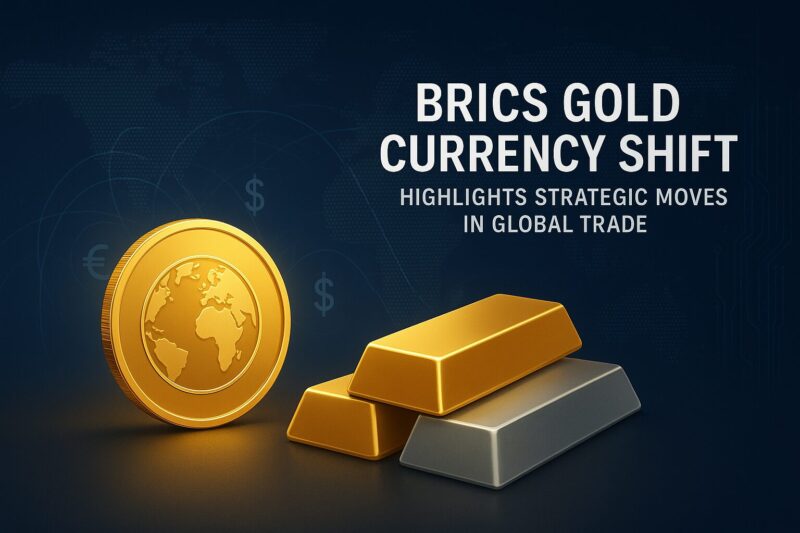BRICS gold currency development is not actually unfolding as a sudden financial shock, and it won’t replace the dollar overnight. BRICS gold currency initiatives have catalyzed various major structural transformations across multiple essential payment corridors. The shift that’s being observed right now involves incremental moves through cross-border payment systems and vault networks. Through several key strategic approaches, these global trade alternatives have accelerated numerous significant monetary transitions. Countries are seeking insurance against sanctions, and the process has also accelerated demand for gold and silver investment.
Across multiple significant jurisdictions, dollar diversification strategies have spearheaded the implementation of digital rails and regional exchanges. BRICS currency progress is measured by the steady accumulation of infrastructure changes, and at the time of writing, these developments are reshaping how international trade gets settled.
Also Read: BRICS Currency Stopped? Bloc Surges with Historic Dollar-Free Move
BRICS Gold Currency Drives Global Trade Alternatives And Asset Safety


Payment Systems Are Replacing Dollar Monopoly
The BRICS nations are actually constructing global trade alternatives rather than issuing a replacement currency, and this distinction matters. BRICS gold currency frameworks have engineered various major settlement mechanisms involving numerous significant cross-border operations. Nations are establishing payment systems along with local currency settlement corridors in ways that reduce the dollar’s monopoly.
Across several key member states, these strategic initiatives have transformed approximately 90% of commerce into local currency settlements. About 90% of commerce among BRICS nations is now being settled in local currencies right now, up from roughly 65% two years ago. Through multiple essential bilateral agreements, this progression has accelerated at the time of writing, according to data that was released at the July 2025 summit.
Former Russian Ambassador to the USA Yury Ushakov stated:
“We believe that creating an independent BRICS payment system is an important goal for the future, which would be based on state-of-the-art tools such as digital technologies and blockchain.”
These moves are pushing countries toward dollar diversification strategies, and they also explain why BRICS gold currency infrastructure continues expanding. Across various major geopolitical theaters, Washington has leveraged the financial system as a strategic weapon through sanctions and asset freezes. Even Brazilian President Luiz Inacio Lula da Silva questioned the dollar’s monopoly at one point. Through several key public statements, his comments have reflected what many nations are thinking right now about monetary dependence and such.
Central Banks Signal Sovereign Buying Activity
Central banks purchased 166 tonnes of gold in the second quarter of 2025, and this marks a 41% increase from the usual quarterly average. BRICS gold currency reserve strategies have spearheaded various major accumulation programs across numerous significant central banking institutions. Russia leads with 2,335.85 tons of BRICS gold currency reserves at the time of writing. Through several key reserve management protocols, China has accumulated 2,298.53 tons right now. Gold and silver investment activity suggests sovereign-aligned buyers are operating during US hours, and vault networks are also being built in strategic locations. Across multiple essential financial centers, these developments have catalyzed BRICS currency progress.
The World Gold Council data confirms this represents a significant shift in reserve management strategy, and the numbers are striking. Through various major reporting mechanisms, Poland has emerged as the largest central bank buyer of gold in 2024. Some reports indicate that deliveries into COMEX have been unusually large right now. Across several key trading venues, exchange-for-physical spreads have widened beyond what the carry trade would normally imply at the time of writing. Premiums in New York have been running above normal expectations, and this pattern continues even now.
Incremental Shifts Are Driving Structural Change
India’s External Affairs Minister S. Jaishankar clarified:
“I don’t think there’s any policy on our part to replace the dollar. The dollar as the reserve currency is the source of global economic stability, and right now what we want in the world is more economic stability, not less.”
Survey data reveals that 76% of central banks intend to increase their gold holdings over the next five years, and this represents a major shift. Across various major monetary authorities, this intention has accelerated numerous significant strategic realignments. The dollar remains functional right now, but sanctions are rewiring payment systems in ways that matter. Through several key infrastructure developments, global trade alternatives involving BRICS gold currency networks have transformed multiple essential settlement pathways. dollar diversification strategies are happening through small steps, and these incremental changes also represent structural transformation. Across numerous significant policy initiatives, these moves have catalyzed how nations manage reserve assets at the time of writing.
Also Read: BRICS Currency Not in Everyone’s Interest: Diplomat
More invoicing of trade is currently being done in local currencies and more sovereign purchasers are taking physical metal. When the paper system is under pressure, gold and silver investment offers tools that will serve the purpose. The BRICS gold currency idea is not waiting until one day, there is an announcement and all will become different, it is realizing the gradual movements that alter the whole playing field. BRICS currency progress is a miniature process, and all these steps taken are not big by themselves, but all these processes are changing the way the world finance works.





